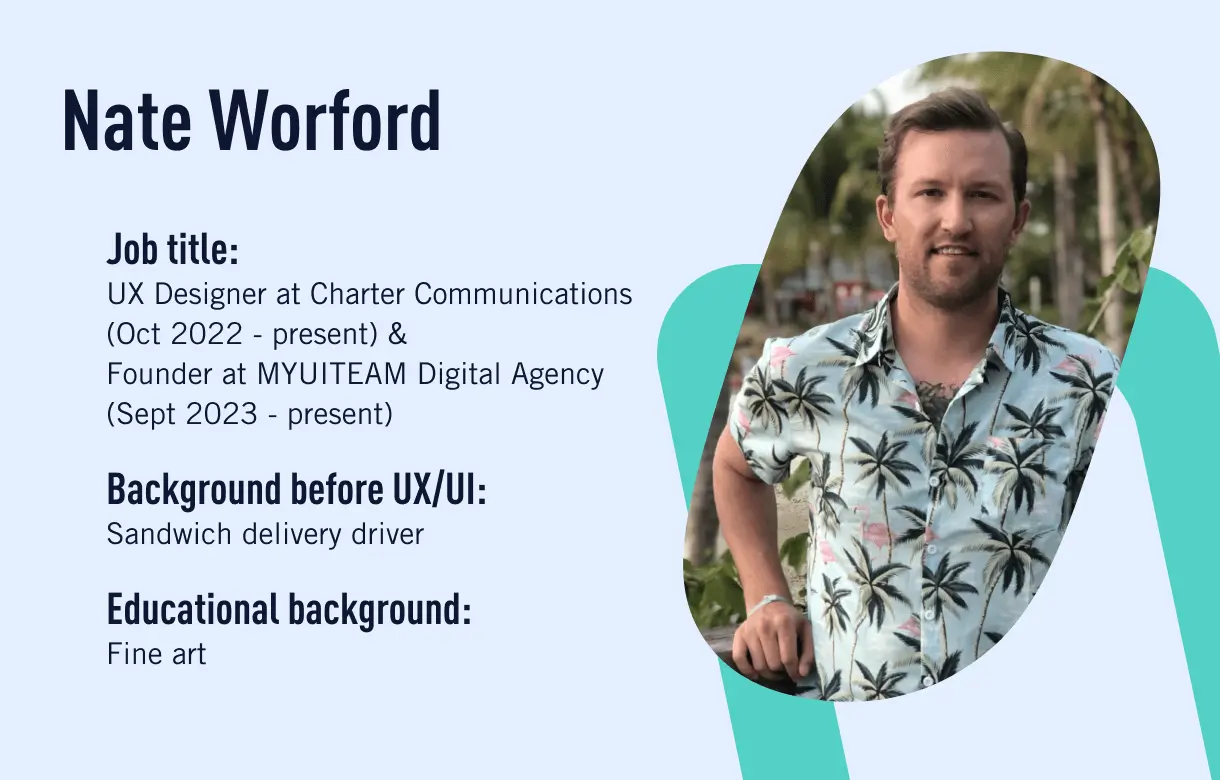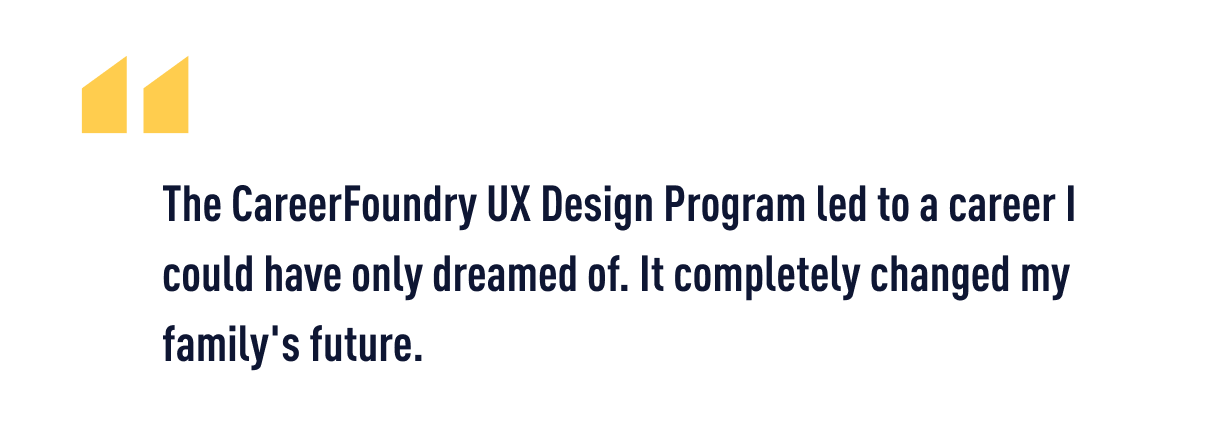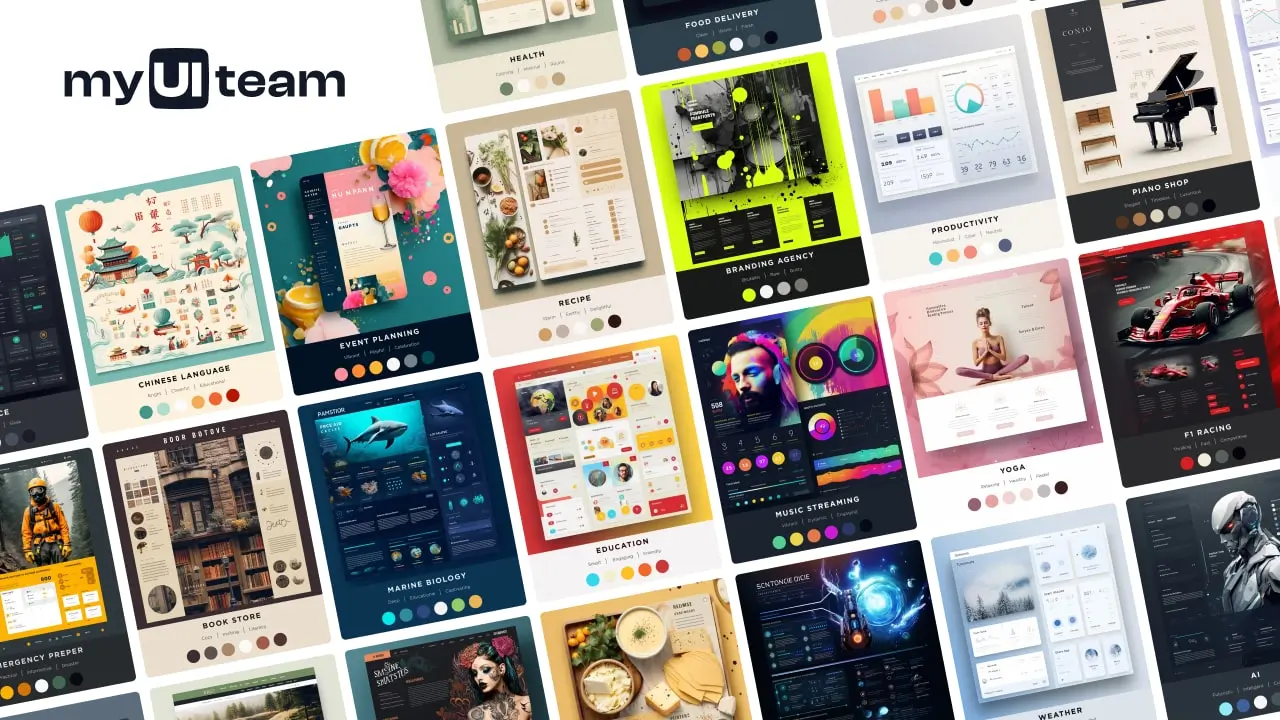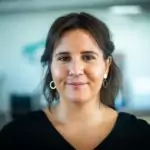
How do you kick off a lasting career when you don’t know exactly what it is you’re passionate about? It’s a common conundrum that affects many of us when we leave school, including Nate. With a passion for design from an early age, he studied fine art, industrial design, and coding after school but still wasn’t sure what his vocation was. Then, he discovered UX/UI design.
While studying at CareerFoundry and taking the UX Design Program, he worked as a sandwich delivery driver, took care of his family, and prepared to build a career in the exciting tech industry and the world of UX/UI design.
And since graduating he’s gone from strength to strength. After landing a UX internship, he then moved on to a full-time UX design role, launched his own design agency (more on that in the interview!), and even became a UI design tutor at CareerFoundry!
Let’s find out how Nate went from design beginner to UX/UI pro…
Hi Nate! Can you tell us a bit about your background?
I grew up doing a lot of art. When I was three years old, my family lived in Paris, France, for a year, and we frequently took trains to visit nearby cities and surrounding countries. While riding the train, my mom put a pencil and paper in my hands, and I’ve been drawing ever since! I always knew I wanted visual design to be part of my career, but I wasn’t quite sure how.
That’s a nice memory! Did you choose to study design after high school?
Well, my education history is sort of all over the place! I attended a few colleges but never achieved a formal degree. After high school, I studied fine art for one year and then I took industrial design courses for a couple of years. I also studied Mandarin while living in China for four years, and did a six-month web development bootcamp.
Wow, very diverse! What led you to CareerFoundry?
I discovered the UX/UI design field during the web development bootcamp. I liked working with technology but never felt like coding was the right fit. After finishing the bootcamp, I searched for UX/UI courses and that’s when I found CareerFoundry. I loved the appeal of the study platform and the job guarantee.
What was the highlight of the program for you?
What made the biggest impact for me was my mentor and tutor. Having live chats with a seasoned professional allowed me to deeply understand the industry, the role, how to approach design projects, and how to build a portfolio. I loved talking one-on-one, asking lots of questions, and getting feedback on my work. I took full advantage of that and met with my mentor every two weeks.
What was the biggest challenge?
At first, I struggled to understand how to put together case studies for my portfolio. I didn’t know how to present my work in a way that was engaging for the viewer and also showed my process, designs, and results.
But, with the help of my mentor in the UX immersion course, I began to understand how to blend storytelling, visuals, and detailed information to create a professional portfolio piece.
Nice! What happened after you finished the course? When did you start job hunting?
While finishing the UI for UX Designers Specialization Course, I launched my portfolio website and began applying for positions at local companies. I actually landed a UX internship before I even finished the course! I worked for a company that provided tech solutions to credit unions.
After that summer internship, they extended my employment and converted me into a salaried employee.

That’s so great to hear. You’ve since moved on from that role. Can you tell us about your current job?
I’m now a UX designer for Charter Communications, a Fortune 100 company that owns and operates Spectrum, a leading broadband connectivity, cable, internet, and cell service provider. I work on internal tools that empower stakeholders, creating innovative concepts and cutting-edge tools.
I have also recently founded a digital agency called MYUITEAM, which provides monthly subscriptions for design and development services.
What’s the most rewarding part of a career in UX/UI design for you?
I love being part of talented software teams and feeling that I’m contributing valuable work. Facing new challenges every day keeps things interesting and fosters continued growth.
The design community is very rewarding. I love to share my experience and be part of the community. To anyone reading this, feel free to DM me on Instagram @nateworford with any questions or just to say hi!
I also enjoy keeping up with new and improving technology with tools like Figma, Framer, Midjourney, and ChatGPT. I’ve recently released a free collection of 50 Website Style Guides on MYUITEAM.com. I used ChatGPT and Midjourney to create the images and I hand-picked the color palettes.

You mentioned some popular AI tools there. How do you think AI will influence or change the design industry?
In the near future, AI looks poised to take over some of the design system and UI design work—for example, AI-powered apps and plugins that generate a full UI kit with minimal input.
Imagine telling AI the purpose and desired functionality of the UI you need to build, selecting a color palette and a typeface or two, and inputting a few key requirements or sources of inspiration. Within seconds, you’ll have a full UI kit with typography, UI elements, and general guidelines!
And before long, AI will be able to search for and scan digital products for inspiration, design customized screens and flows, and even write boilerplate code for a website or app.
That may sound like doomsday for UI designers, but a quick glance at history tells us this won’t be the case. While technological advancements make certain roles obsolete, they also tend to create new, interesting opportunities.
I think this will be the case in our industry, especially considering what is on the horizon with the advent and adoption of AR products like the Apple Vision Pro, which blends digital content with your physical space. Soon, VR and AR technology will take human-computer interaction to a whole new level and open doors we can’t even see yet.
Picture your current interactions with phones, laptops, and computers. Currently, there are only a few ways you can provide input: a mouse click, a finger tap, a swipe on the screen, voice input, or the keyboard. The next generation of products might track your eye movement, facial expression, and the motion of your fingers, opening the door for AI to improve the human experience in a multitude of ways.
How do you think it will affect the role of the UX/UI designer?
I think it will necessitate a workforce of designers with a deep understanding of the human body, psychology, and body language. These topics are all incredibly nuanced, and I think it will be quite some time before companies trust AI to craft user experiences without human input and oversight.
Overall, the job of a UX/UI designer is to humanize technology. We understand humans, technology, and business; our job is to help companies connect the dots. That dynamic will not change.
And soft skills like communication, problem-solving, and leadership will maintain the highest value. While AI can automate certain aspects of the design process, teams of people will still be responsible for building products. I don’t think AI will ever be capable of matching the human capacity for creativity and real-world problem-solving. Those things require a certain spark that I don’t think AI will ever have.
It sounds like you are prepared for the road ahead. What are your hopes for your future career?
To continue to grow my digital agency so that I can provide for my family and achieve a higher level of self-sufficiency and freedom. I hope this will lead to better opportunities for my children and my wife, who is currently applying for medical school.
Great goals. Finally, if you could give any advice to someone who’s either thinking about changing careers or studying with CareerFoundry, what would it be?
Find your motivation, and stay dedicated. Through the long climb into a new career, you need a deep well of fuel to push you when you are low. Always remember what you’re working for, and see the light at the end of the tunnel. Your work ethic should be unwavering, and keep your belief in yourself. You can do this!
Excellent and motivating advice. Thanks, Nate!
If you’ve been inspired by Nate’s story and think a career change to the tech industry sounds like a good opportunity for you too, book a free call with one of our expert program advisors at CareerFoundry. They’ll walk you through our programs, explain what it’s like to study at CareerFoundry and discuss your experience and goals to help you take the next steps in your career change.
If you’re keen to learn more about what a career in tech entails, try one of our free short courses. Take your pick from UX design, UI design, product design, product management, data analytics, digital marketing, and web development, and get a taste of what it’s like to work in tech.
To find out more about other CareerFoundry graduates who broke into tech from unrelated backgrounds, check out these stories:
- How Susana Made a Career Change From Nursing to Product Design
- Starting a New Career at 30: How Julian Became a Data Analyst
- From Biochemistry to Digital Marketing: How Tiago Broadened His Career Path
